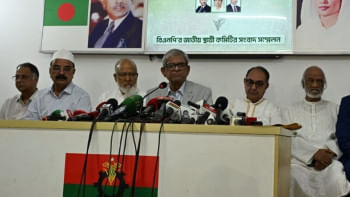Govt study blames it on climate change

Last year's prolonged floods were a “classic example of climate change”, a government study claimed.
During the monsoon, floods are common but the floods in 2017 were distinct with its area covered and intensity, said the study conducted by Local Government Engineering Department (LGED) last year.
According to the study, 54 districts were affected and 10,544km of roads and 23,158 metres culverts and bridges were damaged, which would cost over Tk 8,459 crore to repair.
The government has taken a Tk 2,785 crore project to repair and rebuild some of the damaged infrastructure, 3,764km of roads and 4,000 metres of culverts and bridges in upazila and union levels.
Yesterday, the Executive Committee of the National Economic Council (Ecnec) approved the project for rehabilitation of rural road infrastructure affected by the floods. The project involves 338 upazilas and is scheduled to complete by 2020.
However, Planning Minister AHM Mustafa Kamal after the Ecnec meeting said the project was taken up to improve the roads before the next rainy season.
The repair project excludes damaged roads and structures under the Roads and Highway Department (RHD). The RHD had sought Tk 1,855.58 crore to repair roads and structures under its jurisdiction, according to media reports.
The study, conducted towards the end of last year, said the duration of the floods was not long compared to the floods of 1998 and 2004 “but the depth of the flood and coverage was significant”.
The study said the riverine floods affected new areas and smaller rivers -- Mahananda, Tangon, Punarbhava, Atrai, Korotoa -- which seldom over flowed, burst their banks last year.
Some new districts, like Panchagarh, Dinajpur, and Thakurgaon were affected. These districts have no significant history of flooding, the study said.
During the floods of 1998, 33 districts, mostly central-north and north-eastern, were affected. In 2004, 27 districts were flooded. But last year 54 districts were affected, it said.
“INTENSE RAIN BECAUSE OF CLIMATE CHANGE”
Other than riverine floods, a good number of districts were flooded because of unprecedented heavy rain, the report claimed.
The rainfall of April-May was the highest in 35 years and it wreaked havoc on rural infrastructure. The study said the monsoon was long. It started in April and intermittently continued until October.
“The trend of intensive rainfall because of climate change is being observed since 2011. Year 2017 was another clear demonstration of intensive rainfall,” it said.
TK 3 CRORE FOR TRAINING ABROAD!
The repair project Ecnec approved yesterday earmarks Tk 3 crore for training of project officials abroad.
A total of 60 officials -- 50 from the LGED, five from LGRD ministry and five from the Planning Commission -- will take part in the training programmes in six batches.
The proposed countries include China, Malaysia, Vietnam, Thailand, South Korea, Japan and Switzerland.
Asked about the allocation, the planning minister said they would have trainings abroad to learn how to make roads tougher.
The main work under the project is rebuilding rural roads and structures and LGED officials have years of experience in this field.
So, why they will require foreign training as the minister was asked this question, he said those roads are not strong enough, they will be given foreign training to make the roads more strong.

 For all latest news, follow The Daily Star's Google News channel.
For all latest news, follow The Daily Star's Google News channel. 








Comments